Green nanotechnology focuses on eco-friendly practices that develop sustainable, non-toxic nanomaterials while reducing energy use and waste. It leverages natural compounds like plant extracts and microbes for safer synthesis, minimizing environmental impact. Applications include improving renewable energy devices, pollution cleanup, and eco-conscious healthcare. If you want to explore how these innovative solutions protect the environment and promote sustainability, there’s much more to discover about this green future.
Key Takeaways
- Green nanotechnology integrates environmentally friendly synthesis methods using natural agents like plant extracts and biomolecules.
- It emphasizes designing biodegradable, non-toxic nanomaterials to minimize ecological and health impacts.
- Sustainable practices include resource efficiency, energy conservation, and replacing hazardous chemicals with eco-friendly alternatives.
- Applications span renewable energy, pollution control, and environmental remediation using nanostructured, eco-conscious materials.
- Advances focus on safe, scalable production methods and regulatory frameworks to promote sustainable nanotechnology development.
Understanding Green Nanotechnology and Its Principles
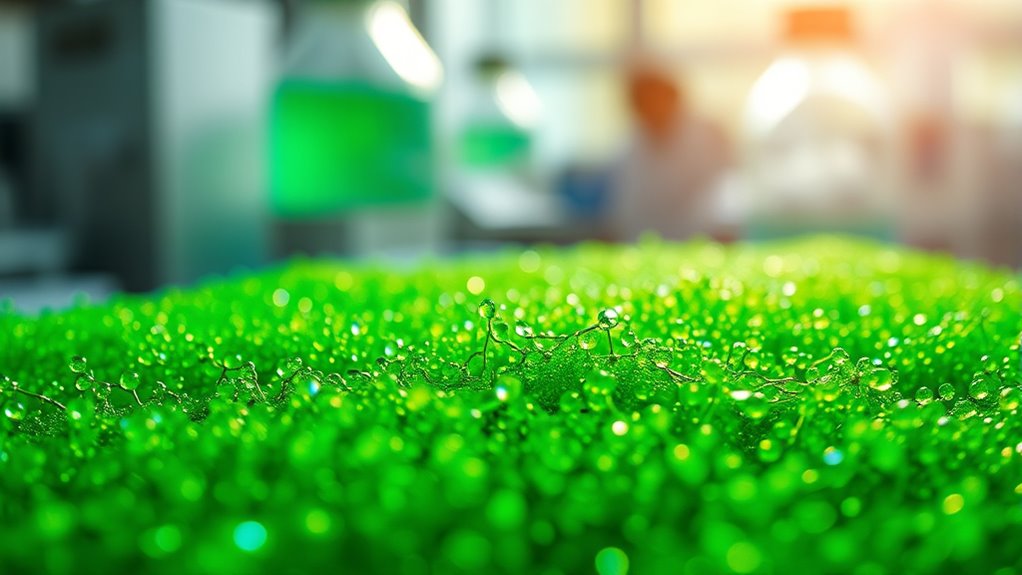
Green nanotechnology combines nanoscience with environmentally friendly practices to develop sustainable solutions. You focus on creating nanomaterials and devices that minimize environmental impact while maintaining performance. Its core principles include reducing the use of hazardous substances, conserving energy, and promoting safe, eco-friendly processes. You prioritize designing nanomaterials that are biodegradable or non-toxic, ensuring they don’t harm ecosystems. Green nanotechnology also emphasizes resource efficiency, meaning you use fewer raw materials and generate less waste. By incorporating renewable energy sources and avoiding harmful chemicals, you help safeguard the environment. Additionally, ethical hacking principles can be applied to ensure the security of nanotech systems against cyber threats, promoting safe deployment of these innovations. This approach ensures that nanotechnology’s advancements contribute positively to sustainability goals, aligning technological progress with ecological responsibility. Ultimately, you aim for innovations that benefit both society and the planet.
Eco-Friendly Synthesis of Nanomaterials
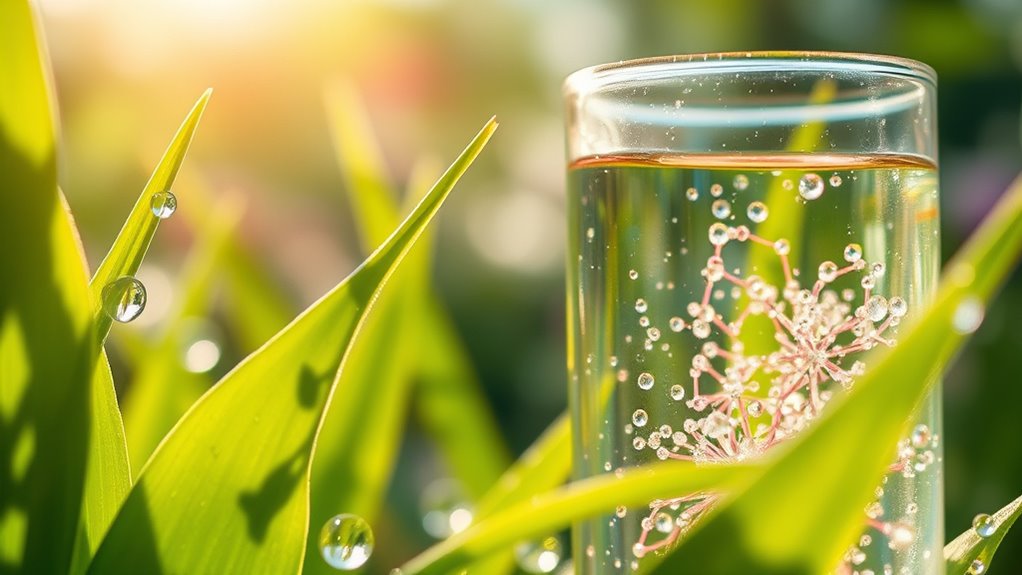
You can create nanomaterials using natural reducing agents like plant extracts and bacteria, making the process safer and more sustainable. Green synthesis techniques avoid harmful chemicals, relying instead on eco-friendly precursors. By choosing these methods, you reduce environmental impact while producing high-quality nanomaterials. Additionally, implementing sustainability initiatives in the synthesis process helps to further minimize ecological footprints.
Natural Reducing Agents
How can natural reducing agents transform the synthesis of nanomaterials into an eco-friendly process? By replacing toxic chemicals with plant extracts, fruit peels, or other biological substances, you can markedly reduce environmental harm. These agents contain compounds like polyphenols, flavonoids, and antioxidants that effectively reduce metal ions to their nanoparticle form. This approach eliminates hazardous reagents and minimizes waste. Natural reducing agents also make the process safer for workers and ecosystems. They often operate under mild conditions, saving energy and lowering costs. Additionally, using renewable biological sources promotes sustainability. By adopting natural reducing agents, you create a greener, safer pathway for nanomaterial production that aligns with eco-conscious principles and reduces your carbon footprint. Emphasizing cultural intelligence can further improve the collaboration and understanding across multidisciplinary teams working on sustainable technologies.
Green Synthesis Techniques
Have you ever wondered how nanomaterials can be produced without harming the environment? Green synthesis techniques offer eco-friendly alternatives that minimize toxic waste and energy use. You can harness biological entities like plants, bacteria, and fungi to reduce metal ions into nanomaterials naturally. These methods often operate under mild conditions, avoiding harsh chemicals and high temperatures. By choosing green synthesis, you contribute to sustainable development and reduce ecological footprints. Here are some key approaches you might explore:
- Using plant extracts as reducing and stabilizing agents
- Employing microorganisms for biogenic synthesis
- Leveraging enzymes to control nanoparticle formation
- Implementing aqueous-based processes for safer reactions
These techniques make nanomaterial production safer, cleaner, and more sustainable, aligning with scientific inquiry eco-friendly goals.
Eco-Friendly Precursors
Eco-friendly precursors are essential components in sustainable nanomaterial synthesis, as they replace traditional hazardous chemicals with safer, naturally derived substances. You can use plant extracts, biopolymers, and waste materials as sustainable sources, reducing environmental impact and health risks. These precursors often contain bioactive compounds that facilitate nanoparticle formation without toxic reagents. For example, extracts from fruits, leaves, or herbs can act as reducing and stabilizing agents, simplifying synthesis processes. Using eco-friendly precursors also promotes biodegradability and renewability, making the entire process more sustainable. By choosing natural precursors, you contribute to greener production methods, minimize waste, and support eco-conscious innovation in nanotechnology. Understanding the importance of color accuracy can help optimize the visual quality of nanomaterials and their applications. This approach aligns with the broader goal of developing safer, eco-friendly nanomaterials for diverse applications.
Applications in Sustainable Energy Solutions
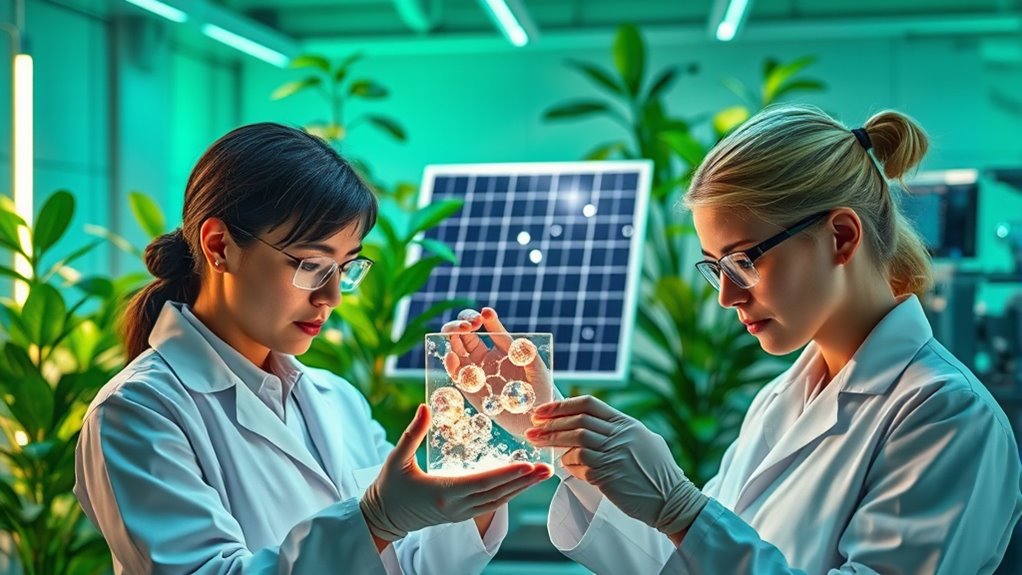
Green nanotechnology plays a pivotal role in advancing sustainable energy solutions by developing innovative materials and processes that reduce environmental impact. By harnessing nanoscale materials, you can improve the efficiency of solar panels, creating lightweight, flexible, and more cost-effective photovoltaic devices. Nanostructured catalysts enhance biofuel production, making it more sustainable and scalable. You can also develop energy storage systems, like nanocomposite batteries, with higher capacity and faster charging times. Additionally, using eco-friendly nanomaterials in wind turbine components reduces weight and increases durability. These advancements enable you to design cleaner, more efficient energy technologies that lower carbon footprints and promote renewable energy adoption. Incorporating eco-friendly nanomaterials into energy systems further supports sustainability goals by minimizing environmental hazards.
Biodegradable Nanocomposites for Environmental Remediation

Biodegradable nanocomposites are transforming environmental remediation by offering effective solutions that naturally break down after use. These materials target pollutants like heavy metals and organic contaminants, providing eco-friendly cleanup options. Their biodegradability minimizes long-term environmental impact, making them ideal for sustainable practices. When selecting nanocomposites, consider factors like degradation rate, pollutant affinity, and material strength. Here’s a comparison to help you choose:
| Feature | Biodegradability | Pollutant Affinity | Strength |
|---|---|---|---|
| Supports eco-friendly cleanup | High | Moderate to High | Sufficient for many applications |
| Reduces waste accumulation | Yes | Varies | Varies |
| Suitable for sensitive environments | Yes | High | Adequate for remediation tasks |
| Cost-effectiveness | Increasing | Competitive | Varies |
| Overall sustainability | Excellent | High | Sufficient |
This table highlights how biodegradable nanocomposites balance environmental benefits with performance needs. Additionally, advancements in nanotechnology enable material customization to enhance specific remediation outcomes.
Pollution Reduction Through Nano-Enabled Technologies
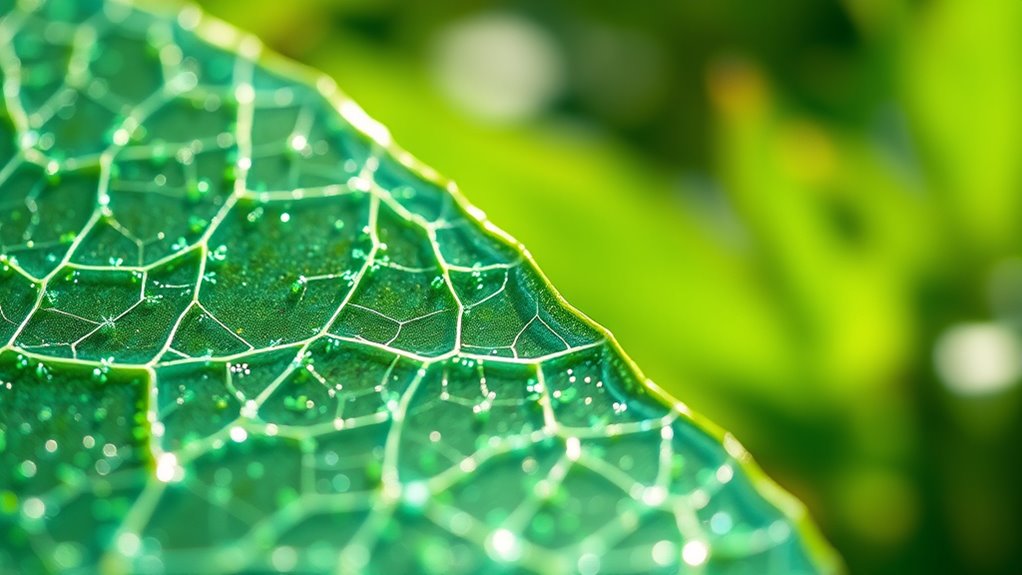
Nanotechnology has revolutionized pollution control by enabling the development of advanced materials and processes that efficiently detect, contain, and remove contaminants. Nano-enabled sensors can identify pollutants at incredibly low concentrations, allowing for early detection and rapid response. Nanostructured filters and membranes trap toxins more effectively than traditional methods, reducing wastewater and air pollution. Nanocatalysts accelerate breakdown processes, transforming harmful substances into benign compounds, minimizing environmental impact. These innovations make pollution management more precise, cost-effective, and eco-friendly. Preppy Dog Names offer a stylish way to personalize pets, reflecting the same level of sophistication found in nanotechnology innovations. – Enhanced detection of pollutants at trace levels – More efficient filtration of air and water contaminants – Accelerated degradation of hazardous chemicals – Reduced reliance on harmful chemicals and energy-intensive methods
Green Nanotechnology in Medical and Healthcare Fields

Have you ever wondered how cutting-edge nanomaterials are transforming medicine and healthcare? Green nanotechnology enables the development of eco-friendly, biocompatible nanomaterials that improve diagnostics, drug delivery, and tissue engineering. You can benefit from targeted treatments that minimize side effects because nanoparticles can precisely deliver medications to affected areas. These materials often use sustainable synthesis methods, reducing toxic waste and energy consumption. Green nanotech also enhances imaging techniques, making diagnoses faster and more accurate. In wound healing, eco-friendly nanomaterials promote faster recovery without harmful chemicals. By integrating sustainability into medical innovations, you support safer, greener healthcare solutions. This approach not only advances patient care but also aligns with environmental preservation, making medicine more responsible and eco-conscious. Additionally, data analytics in green nanotechnology help optimize design and application processes, leading to more effective and sustainable medical solutions.
Challenges and Future Directions of Eco-Conscious Nanotech
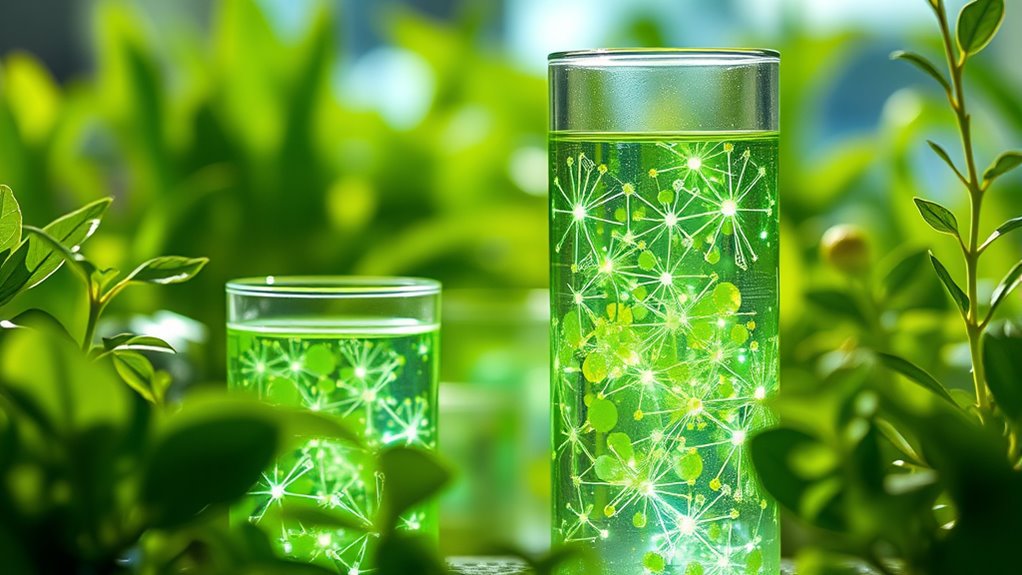
While eco-conscious nanotech holds great promise for sustainable advancements, it faces significant hurdles that must be addressed. One major challenge is ensuring the safety of nanomaterials for both humans and the environment, which requires thorough testing and regulation. Additionally, scaling up eco-friendly production methods while maintaining cost-effectiveness remains difficult. Limited understanding of long-term ecological impacts of nanomaterials poses another obstacle. Funding and public acceptance also influence research progress and implementation. Looking ahead, future directions include developing standardized safety protocols, improving green synthesis techniques, and fostering interdisciplinary collaboration to innovate sustainable solutions. Enhancing regulatory frameworks is essential to support safe and responsible development in this field.
Collaborations and Policies Promoting Sustainable Nanoscience

You play a key role in shaping effective regulatory frameworks and standards that guarantee safe and sustainable nanotechnology practices. Public-private partnerships can accelerate innovation while preserving environmental integrity. By fostering collaboration, you help create policies that support responsible development in green nanoscience.
Regulatory Frameworks and Standards
Regulatory frameworks and standards play a crucial role in guiding the development of sustainable nanoscience by establishing clear safety, environmental, and ethical guidelines. These policies ensure responsible research and commercial use of nanomaterials, minimizing risks to health and the environment. They also promote transparency and public trust in nanotechnology innovations. International agencies and governments collaborate to create harmonized regulations that support safe development while fostering innovation. You should be aware of key aspects such as testing protocols, labeling requirements, and environmental impact assessments. Staying informed about evolving standards helps you comply and contribute to sustainable practices.
- Establishing safety thresholds for nanomaterials
- Developing standardized testing methods
- Implementing labeling and disclosure rules
- Promoting international regulatory harmonization
Public-Private Partnerships
How can collaborations between public agencies and private companies accelerate sustainable nanoscience? By combining resources, expertise, and research capabilities, these partnerships foster innovation and streamline development of eco-friendly nanomaterials. Public agencies often provide funding, regulatory guidance, and infrastructure, while private companies contribute practical insights, market knowledge, and commercialization pathways. Together, you can set shared goals for sustainability, ensuring projects align with environmental standards. These collaborations also promote knowledge exchange, reducing duplication and accelerating breakthroughs. Policies that incentivize joint ventures, grants, and tax benefits motivate your organization to participate actively. Ultimately, public-private partnerships help you develop safer, greener nanotechnologies faster, bridging the gap between research and real-world application while advancing sustainability in nanoscience.
Frequently Asked Questions
How Does Green Nanotechnology Compare Economically to Traditional Nanotech?
Green nanotechnology can be more cost-effective over time because it reduces the need for expensive, toxic chemicals and energy-intensive processes. You might find initial investments higher, but the long-term savings on materials and environmental cleanup make it economically competitive. Plus, eco-friendly approaches can open up new markets and meet increasing consumer demand for sustainable products, ultimately boosting your profitability and brand reputation.
What Are Potential Environmental Risks of Nanomaterials?
You should be aware that nanomaterials can pose environmental risks like toxicity to aquatic life, soil contamination, and bioaccumulation. These tiny particles might seep into ecosystems during manufacturing or disposal, potentially harming plants, animals, and humans. Additionally, their unknown long-term impacts raise concerns. Hence, handling nanomaterials responsibly, implementing safety measures, and conducting thorough research are essential to minimize environmental risks.
How Scalable Are Eco-Friendly Nanomaterial Production Methods?
Think of eco-friendly nanomaterial production methods like planting a garden; they can be scaled up, but it takes time and careful planning. You can expand these methods from small batches to larger productions, but challenges like maintaining quality and minimizing environmental impact remain. With technological advancements and sustainable practices, you can increase production capacity, making eco-friendly nanomaterials more accessible for widespread use, though it requires ongoing effort and innovation.
What Certifications Exist for Eco-Friendly Nanomaterials?
You’ll find certifications like ISO 14001 for environmental management and Green Seal for eco-friendly products that apply to nanomaterials. These certifications guarantee that the production processes meet strict sustainability standards and minimize environmental impact. Additionally, some regions might have specific green certifications or labeling systems for nanotechnology products. Always verify if your nanomaterials meet these certifications to ensure they’re genuinely eco-friendly and sustainably produced.
Can Green Nanotech Be Integrated With Existing Industrial Processes?
You can definitely integrate green nanotech into existing industrial processes. By blending bio-based benefits with bold, sustainable strategies, you streamline operations while reducing environmental impacts. You’ll find that incorporating eco-friendly nanomaterials enhances efficiency, encourages eco-conscious efforts, and aligns with evolving regulations. With careful calibration and collaboration, you turn traditional practices into transformative, environmentally responsible processes, making sustainability a seamless, sustainable, and smart part of your industrial innovations.
Conclusion
By embracing green nanotechnology, you can contribute to a more sustainable future. Did you know that eco-friendly nanomaterials can reduce energy consumption by up to 30% in various applications? As you explore eco-conscious practices, remember that innovative, biodegradable nanomaterials are transforming industries and helping protect our planet. Your support and awareness can drive the adoption of sustainable nanotech, making a real difference for future generations.









